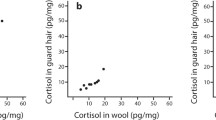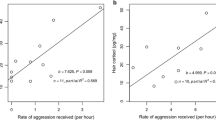Abstract
Understanding how social relationships affect long-term stress is important because stress has a profound impact on the welfare of animals and social relationships often exert a strong influence on their stress responses. The purpose of this study was to investigate the relationship between social behaviors and long-term stress levels as assessed by hair cortisol (HC) concentration. The subjects were 11 chimpanzees living in an all-male group (divided into two sub-groups) in Kumamoto Sanctuary, Kyoto University, Japan. Behavioral data were collected between December 2014 and March 2015. The total observation time was 129 h. Hair samples were collected in late March and early April 2015, and cortisol was extracted from the hair and measured with enzyme immunoassay. The hair growth rate was estimated to be 1.33 ± 0.06 cm/month. The results revealed that there was a positive correlation between the rate of receiving aggression and HC levels. We also found a significant negative correlation between the balance between giving and receiving grooming (grooming balance index: GBI), which was calculated by subtracting the rate with which grooming is given from that with which it is received, and the rate of receiving aggression and between the GBI and HC levels. Thus, individuals receiving higher levels of aggression also tended to give grooming for relatively long periods compared to the time they were being groomed. In contrast, the rate of initiating aggression did not have a relationship with either HC levels or any measure of social grooming. We did not find social buffering effects, as there was no correlation between mutual social grooming and HC levels. These results show that not only aggressive interactions but also overall social situations in which animals do not have balanced relationships with others might result in the long-term elevation of cortisol levels in captive male chimpanzees.


Similar content being viewed by others
References
Abbott DH et al (2003) Are subordinates always stressed? A comparative analysis of rank differences in cortisol levels among primates. Horm Behav 43:67–82. https://doi.org/10.1016/s0018-506x(02)00037-5
AZA Ape Taxon Advisory Group (2010) Chimpanzee (Pan troglodytes) Care Manual. Association of Zoos and Aquariums
Bahr NI, Palme R, Mohle U, Hodges JK, Heistermann M (2000) Comparative aspects of the metabolism and excretion of cortisol in three individual nonhuman primates. Gen Comp Endocrinol 117:427–438
Broom DM, Johnson KG (1993) Stress and animal welfare. Chapman & Hall animal behaviour series. Chapman & Hall, London
Cohen S (2004) Social relationships and health. Am Psychol 59:676
Davenport MD, Tiefenbacher S, Lutz CK, Novak MA, Meyer JS (2006) Analysis of endogenous cortisol concentrations in the hair of rhesus macaques. Gen Comp Endocrinol 147:255–261
Freeman HD, Ross SR (2014) The impact of atypical early histories on pet or performer chimpanzees. PeerJ 2:e579. https://doi.org/10.7717/peerj.579
Fritz J, Howell S (2001) Captive chimpanzee social group formation. In: Brent L (ed) The care and management of captive chimpanzees, vol 2. American Society of Primatologists, San Antonio, pp 173–204
Goodall J (1986) The chimpanzees of Gombe: patterns of behaviour. Harvard University Press, Cambridge
Hennessy MB, Kaiser S, Sachser N (2009) Social buffering of the stress response: diversity, mechanisms, and functions. Front Neuroendocrinol 30:470–482. https://doi.org/10.1016/j.yfrne.2009.06.001
Hothorn T, Hornik K, van de Wiel MA, Zeileis A (2008) Implementing a class of permutation tests: the coin package. J Stat Softw 28:1–23
Kikusui T, Winslow JT, Mori Y (2006) Social buffering: relief from stress and anxiety. Philos Trans R Soc Lond B Biol Sci 361:2215–2228
Machanda ZP, Gilby IC, Wrangham RW (2014) Mutual grooming among adult male chimpanzees: the immediate investment hypothesis. Anim Behav 87:165–174. https://doi.org/10.1016/j.anbehav.2013.10.028
Martin P, Bateson P (2007) Measuring behaviours: an introductory guide, 3rd edn. Cambridge University Press, Cambridge
Mastromonaco GF, Gunn K, McCurdy-Adams H, Edwards DB, Schulte-Hostedde AI (2014) Validation and use of hair cortisol as a measure of chronic stress in eastern chipmunks (Tamias striatus). Conserv Physiol 2:cou055. https://doi.org/10.1093/conphys/cou055
Mitani JC (2009) Male chimpanzees form enduring and equitable social bonds. Anim Behav 77:633–640. https://doi.org/10.1016/j.anbehav.2008.11.021
Morimura N, Idani G, Matsuzawa T (2010) The first chimpanzee sanctuary in Japan: an attempt to care for the “surplus” of biomedical research. Am J Primatol 73:226–232. https://doi.org/10.1002/ajp.20887
Muller MN, Wrangham RW (2004) Dominance, cortisol and stress in wild chimpanzees (Pan troglodytes schweinfurthii). Behav Ecol Sociobiol 55:332–340. https://doi.org/10.1007/s00265-003-0713-1
Nishida T, Zamma K, Matsusaka T, Inaba A, McGrew WC (2010) Chimpanzee behavior in the wild: an audio-visual encyclopedia. Springer, Tokyo
Noe R, de Waal FB, Van Hooff J (1980) Types of dominance in a chimpanzee colony. Folia Primatol (Basel) 34:90–110
Ogura T (2013) A digital app for recording enrichment data. Shape Enrich 22:3
R Development Core Team (2017) R: A language and environment for statistical computing. http://www.R-project.org/
Russell E, Koren G, Rieder M, Van Uum S (2012) Hair cortisol as a biological marker of chronic stress: current status, future directions and unanswered questions. Psychoneuroendocrinology 37:589–601
Sapolsky RM (2005) The influence of social hierarchy on primate health. Science 308:648–652. https://doi.org/10.1126/science.1106477
Silk JB et al (2010) Strong and consistent social bonds enhance the longevity of female baboons. Curr Biol 20:1359–1361. https://doi.org/10.1016/j.cub.2010.05.067
Silk J, Cheney D, Seyfarth R (2013) A practical guide to the study of social relationships. Evol Anthropol Issues News Rev 22:213–225. https://doi.org/10.1002/evan.21367
Tennenhouse EM, Putman S, Boisseau NP, Brown JL (2017) Relationships between steroid hormones in hair and social behaviour in ring-tailed lemurs (Lemur catta). Primates 58:199–209. https://doi.org/10.1007/s10329-016-0566-7
Terwissen CV, Mastromonaco GF, Murray DL (2013) Influence of adrenocorticotrophin hormone challenge and external factors (age, sex, and body region) on hair cortisol concentration in Canada lynx (Lynx canadensis). Gen Comp Endocrinol 194:162–167. https://doi.org/10.1016/j.ygcen.2013.09.010
Wittig RM, Crockford C, Weltring A, Deschner T, Zuberbühler K (2015) Single aggressive interactions increase urinary glucocorticoid levels in wild male chimpanzees. PLoS ONE 10:e0118695. https://doi.org/10.1371/journal.pone.0118695
Wittig RM, Crockford C, Weltring A, Langergraber KE, Deschner T, Zuberbühler K (2016) Social support reduces stress hormone levels in wild chimpanzees across stressful events and everyday affiliations. Nat Commun 7:13361. https://doi.org/10.1038/ncomms13361. http://www.nature.com/articles/ncomms13361#supplementary-information
Wooddell LJ et al (2017) Relationships between affiliative social behavior and hair cortisol concentrations in semi-free ranging rhesus monkeys. Psychoneuroendocrinology 84:109–115. https://doi.org/10.1016/j.psyneuen.2017.06.018
Yamanashi Y, Morimura N, Mori Y, Hayashi M, Suzuki J (2013) Cortisol analysis of hair of captive chimpanzees (Pan troglodytes). Gen Comp Endocrinol 194:55–63. https://doi.org/10.1016/j.ygcen.2013.08.013
Yamanashi Y, Teramoto M, Morimura N, Hirata S, Inoue-Murayama M, Idani G (2016a) Effects of relocation and individual and environmental factors on the long-term stress levels in captive chimpanzees (Pan troglodytes): monitoring hair cortisol and behaviors. PLoS ONE 11:e0160029. https://doi.org/10.1371/journal.pone.0160029
Yamanashi Y et al (2016b) Analysis of hair cortisol levels in captive chimpanzees: effect of various methods on cortisol stability and variability. MethodsX 3:110–117. https://doi.org/10.1016/j.mex.2016.01.004
Yamanashi Y, Nogami E, Teramoto M, Morimura N, Hirata S (2017) Adult-adult social play in captive chimpanzees: is it indicative of positive animal welfare? Appl Anim Behav Sci. https://doi.org/10.1016/j.applanim.2017.10.006
Acknowledgements
The care of the chimpanzees and the present study were supported financially by grants from the Japan Society for the Promotion of Science (#13J04636 and #17K17828 to YY, #25119008 to SH, #15H0579, #16H06301, #16H06283, JSPS-LGP-U04, JSPS core-to-core CCSN) and also by Future Development Funding Program of Kyoto University Research Coordination Alliance and Great Ape Information Network. We are grateful to the following people and program for their support of our study: Yusuke Mori, Toshifumi Udono and the staff at the Kumamoto Sanctuary, and Great Ape Information Network.
Author information
Authors and Affiliations
Corresponding author
Electronic supplementary material
Below is the link to the electronic supplementary material.
About this article
Cite this article
Yamanashi, Y., Teramoto, M., Morimura, N. et al. Social relationship and hair cortisol level in captive male chimpanzees (Pan troglodytes). Primates 59, 145–152 (2018). https://doi.org/10.1007/s10329-017-0641-8
Received:
Accepted:
Published:
Issue Date:
DOI: https://doi.org/10.1007/s10329-017-0641-8




